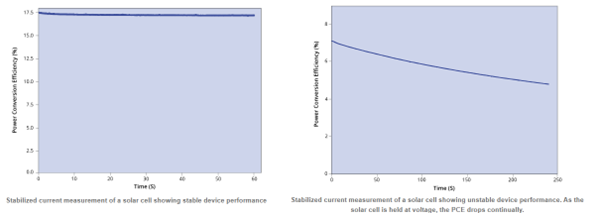Sponsored by Ossila LtdReviewed by Olivia FrostDec 20 2024
Perovskite solar cells (PSCs) represent a significant breakthrough in photovoltaic (PV) technology, with their rapid efficiency improvements and potential for diverse applications. These devices have the ability to transform the solar energy industry, but their stability remains a significant barrier to commercialization. Unlike mature technologies like silicon solar cells, PSCs face unique challenges due to their susceptibility to environmental, thermal, and operational stresses.
Issues with Perovskite Solar Cell Stability
To compete with established photovoltaic technologies, PSCs must demonstrate long operational lifetimes, spanning 20-25 years under real-world conditions to match the lifetimes of silicon PV. However, PSCs are particularly vulnerable to degradation caused by environmental factors such as moisture, temperature fluctuations, prolonged light exposure, and electrical stress.
The impact of perovskite instability on the power conversion efficiency (PCE) of a PSC is both immediate and long-term, leading to a gradual or sudden reduction in device performance.

Image Credit: Ossila Ltd
Moisture poses a major issue to perovskite stability, as water vapor interacts with the perovskite material, gradually breaking down its structure. High temperatures accelerate this decomposition, which in turn compromises efficiency and longevity.
Prolonged exposure to UV light can also encourage photochemical reactions, ion migration, and phase segregation. This light-induced degradation can further undermine performance. These material-level issues are exacerbated by device-level instabilities, such as imperfections at interfaces, electrode deterioration, and structural flaws. Overcoming this web of challenges is critical for unlocking the full potential of PSC technology.
Perovskite Solar Cell Stability Measurements
Accurate and standardized measurement techniques are essential to understanding and mitigating the stability issues of PSCs.
Testing Under Voltage/Current Tracking or Maximum Power Point Testing
Initially, simple current voltage measurements were used to test perovskite solar cell performance. However, these measurements can often be misleading as they don’t represent the stability of PSC devices.
Measuring stabilized measurements under voltage is vital for understanding how PSCs perform under real-world operational conditions. Among these, Maximum Power Point Tracking can evaluate the device's efficiency during continuous operation by holding the device at the voltage at which it functions most effectively.
Another essential technique, hysteresis analysis, highlights the discrepancies observed in current-voltage (J-V) curves when voltage sweeps are performed in forward and reverse directions. Furthermore, stabilized current-voltage testing offers a more reliable insight into the device’s true operational performance. Additionally, aging studies monitor the evolution of J-V curves and stabilized metrics over time, shedding light on how PSCs degrade during extended use.
Together, these methods form a comprehensive picture of a device's durability and performance stability.
Light Stability Testing
Light stability testing plays a critical role in understanding how PSCs degrade under continuous illumination.
A solar simulator with an adjustable light intensity and spectrum replicates sunlight exposure, allowing researchers to observe the effects of prolonged light exposure. This includes identifying photochemical reactions, ion migration, and phase segregation in mixed halide perovskites that can arise under extended illumination.
Light stability tests often complement environmental tests, as light exposure frequently interacts with factors like heat and humidity to accelerate degradation.

Image Credit: Ossila Ltd
Thermal Stability Testing
Thermal stability assessment involves heating PSCs to monitor their structural changes at elevated temperatures. Techniques such as thermogravimetric analysis (TGA) are used to determine the decomposition thresholds of the perovskite material. Operational heat stress tests are also conducted to simulate the high temperatures PSCs may encounter during real-world operation.
Combining thermal and light stability assessments provides a more comprehensive understanding of how heat and light interact to affect device performance.

Image Credit: Ossila Ltd
Standardization in Testing
Standardizing stability testing protocols is critical to ensuring consistency and comparability across the PSC research industry. The International Summit on Organic Photovoltaic Stability has proposed protocols for testing PSCs, which outline key parameters such as the type of light source, spectral irradiance, and environmental conditions. Adopting these protocols promotes uniformity in testing, allowing researchers to benchmark results more effectively.
Reproducibility is a major challenge in stability testing, as differences in laboratory conditions and inconsistent reporting can lead to variability in results. Detailed documentation of testing conditions and standardized protocols can minimize variability and facilitate collaboration among researchers working to improve PSC technology.

This information has been sourced, reviewed and adapted from materials provided by Ossila Ltd.
For more information on this source, please visit Ossila Ltd.